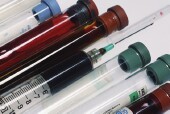
FRIDAY, March 11 (HealthDay News) — A simple and inexpensive blood test designed to uncover early signs of emphysema may one day find its place among the standard work-up that most Americans undergo during their yearly physical, new research suggests.
Although the novel screening method has shown considerable promise in preliminary investigations sponsored by the U.S. National Institutes of Health, the researchers caution that more studies are needed before the test could become available.
An easily administered test that could spot emphysema even before symptoms show up would be an enormous boon to the care of smokers, who are the most vulnerable to the onset of the disabling and potentially deadly disease.
“We know from other studies that smokers who learn from objective evidence that their health is in danger are much more likely to quit,” Dr. Ronald G. Crystal, chairman and professor of genetic medicine and internal medicine at Weill Cornell Medical College and the study’s lead author, said in a news release. “That is the only thing that will help them avoid this deadly disorder.”
“We need a blood test that can be administered to the 20 percent of American adults who smoke as well as nonsmokers exposed to secondhand smoke — all who may not understand their risk of developing this progressive lung disease,” he added.
Crystal, who also serves as chief of the division of pulmonary and critical care medicine at New York-Presbyterian/Weill Cornell Medical Center in New York City, reported his team’s findings in the March 14 online issue of the American Journal of Respiratory and Critical Care Medicine.
Emphysema and chronic bronchitis are the two main conditions of chronic obstructive pulmonary disease (COPD). In the United States, COPD is the fourth leading cause of death and has been projected to increase as the American population ages.
The new screening mechanism for emphysema was designed to measure the presence in the bloodstream of capillary debris, known as endothelial microparticles, or EMP, that results from injury to the lung’s air sacs, called alveoli. The researchers noted that air sacs are central to respiratory function, and their COPD-driven deterioration ultimately shreds the lungs, producing the Swiss-cheese appearance that’s telltale of the disease.
When tested on healthy nonsmokers, healthy smokers and smokers with signs of lung disease, the new test for EMP was found to be nearly foolproof in detecting early signs of emphysema, compared with the current emphysema screening method, known as DLCO, or lung diffusion testing, which measures how well the lungs exchange oxygen and carbon dioxide.
The new test, according to the researchers, also is better than the current one at uncovering the earliest signs of disease and can be done without the involvement of a pulmonologist.
In addition, they said, being able to easily diagnose emphysema at an early stage could be the leg up that health practitioners need to get their patients who smoke to finally kick the addiction.
Dr. Neil Schachter, a professor of pulmonary medicine at Mount Sinai Medical Center in New York City, agreed.
“Only about 15 percent of smokers will go on to develop emphysema,” he noted. “So if you’re a gambler and a smoker, which most are in a very general sense, it may not feel that urgent to stop smoking if you think you have a better-than-even chance of beating the game. But if you know you’re in that 15 percent, it certainly is a powerful argument that physicians can bring forth to help convince people to stop smoking.”
“But even so, smoking is a terrible, huge addiction,” Schachter stressed. “It’s difficult to convince people to quit, even when they know they have symptomatic disease. So it’s not clear this will actually make a difference.”
Edmund J. Miller, head of the Center for Heart and Lung Research at the Feinstein Institute for Medical Research in Manhasset, N.Y., echoed this reservation.
“Since the dangers of smoking have been emphasized in many ways, and many smokers do not quit even when the most severe symptoms have developed, it is perhaps unlikely that an individual will quit because of a blood test,” Miller said. He added that biomarkers and early recognition of disease processes are valuable, however, and “the test may be useful in other settings where deterioration of lung function may be a late finding that perhaps could be prevented.”
“This is a new finding in emphysema,” Miller said, “but these particles [EMP] have been proposed as potential biomarkers for several other diseases, including sepsis and vasculitis.”
Dr. Norman Edelman, chief medical officer of the American Lung Association (ALA), agreed that it’s unknown whether the new test would prove to be a quit-smoking aid.
“I cannot predict whether this new test will be an important tool in helping doctors convince their patients to stop smoking,” Edelman said. “The ALA recommends that doctors make strong efforts at smoking cessation for all of their smoking patients, as it is proven that doctors’ intervention is an effective way to get people to make a serious attempt to quit.” How much this test might add to either the quality of the doctors’ efforts or the patients’ response was uncertain, he noted.
But Schachter added that early detection can make all the difference in managing emphysema.
“If you catch the disease early, while there may be some microscopic damage, you are still way ahead of the game,” he said. “And if the person stops smoking and takes proper prevention measures, such as following a healthy lifestyle, you could probably slow down the disease and maintain it at a level as either asymptomatic as it is at the time of discovery or mildly symptomatic.”
More information
The Cleveland Clinic has more on emphysema and COPD.

